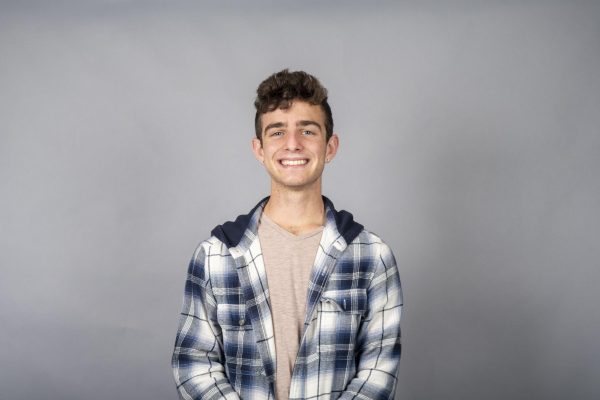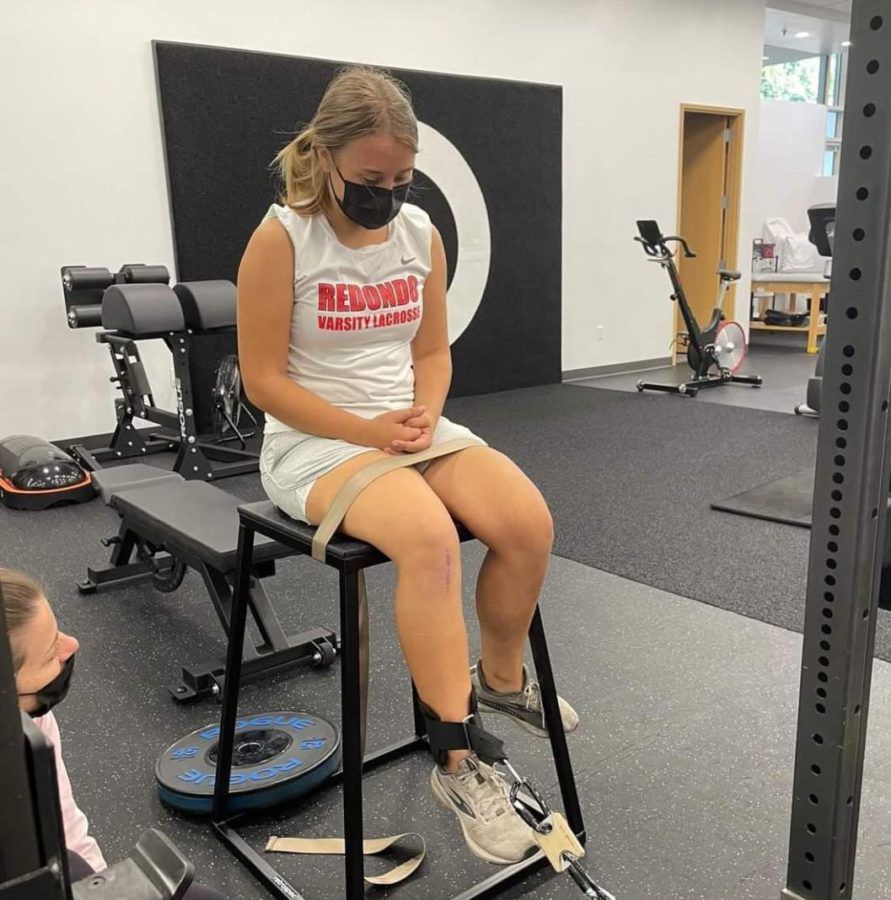Captain on Crutches
Junior Kylie Thompson spreads awareness of ACL injuries for female athletes while documenting her own recovery process on social media.
Making a move around a defender with the ball, junior lacrosse attacker Kylie Thompson prepared to make a pass to her teammate, stepping and planting her foot when suddenly she felt a pop and her knee twisted in a different direction. The pain was immediate and overwhelming, and in an instant, Thompson’s career as a high-school athlete completely changed.
Thompson tore her ACL during a lacrosse tournament on the East Coast over the summer, and got surgery soon after. Originally misdiagnosed as a hamstring pull, an MRI proved that it was actually an ACL tear, a devastating revelation for Thompson due to the predicted year long recovery process.
“I’m still not able to run and it’s been three months post surgery—that’s normal,” Thompson said. “I’m really unable to play sports because I need to twist my knee in some way for anything. So I can’t exactly practice at all.”
As the girl’s varsity team captain, this injury has been particularly difficult for Thompson, but she is not alone in this problem. ACL injuries have increased by 147% among 14 to 18-year-olds in the last 10 years, according to the American Academy of Pediatrics. Girls lacrosse assistant coach and history teacher, Samantha Marcon, also tore her ACL and struggled to deal with the sudden inability to be active.
“It felt dehumanizing,” Marcon said. “It’s hard to have to rely on someone so much when you’ve been independent for such a long time. I felt like I was a baby and someone had to take care of me, which I had never experienced before as an adult.”
Thompson’s teammate, junior Madeline Langa, tore her ACL completely after being pushed by an opponent in a match last spring. Langa highlighted the potentially life-changing ramifications of an ACL tear.
“Having an ACL tear would severely affect people trying to get recruited to college because if I wanted to go to college and play sports, I would basically be unable to because I’m going to be out for a year and a half, not at my best,” Langa said. “I couldn’t have gotten recruited and I think that it’s imperative that we recognize for some people that this injury could potentially change the course of their life.”
Thompson is one of those people, and after her initial frustration, she looked to make the best out of her situation. As a member of Girl Scouts, Thompson realized that this was an opportunity to complete her Gold Award, an undertaking that requires her to make a difference in her community via an approved 80-hour project.
“I decided the best way I could try to turn this negative into a positive was to document my journey through my ACL tear while spreading awareness on it,” Thompson said. “I have an Instagram (@kylieacljourknee05) and a website where I’m putting information about my journey because I realized that I don’t really know what to expect and it’s such a long process.”
In addition to using social media to share her story, Thompson also plans to host a symposium in partnership with the Cedar-Sinai Kerlan-Jobe Institute in the auditorium on Feb. 2. Hosting several professionals in the medical field, Thompson is optimistic about the symposium’s benefits.
“I’m having multiple speakers to talk about why females are more susceptible to and ways to prevent ACL tears and providing more resources to coaches and students, players, and families about prevention exercises you can do that can limit your chances of a tear,” Thompson said.
Addressing the mental health aspect that injuries such as an ACL tear cause, Thompson also runs the school’s chapter of the Morgan’s Message Club. According to their website, the nonprofit “strives to eliminate the stigma surrounding mental health within the student-athlete community and equalize the treatment of physical and mental health in athletics.”
“Athletes always have that mentality of, ‘Go, go, go push through.’ You can’t really do that with your mental health,” Thompson said. “Obviously athletes’ mental health would be at a lower point when they’re injured. My project is more focused on the recovery and prevention part of it, but I’m able to correlate both of them by talking about how it can mentally affect you when you’re injured and how to retain a positive attitude through it.”
Langa has been following Thompson’s project via her Instagram account for its “relatable content” concerning the recovery process, and agrees with the value of the discussion on the prevention of ACL injuries.
“I think we can prevent injuries by raising caution amongst athletes while playing this sport. Maybe train them in certain ways to fall, especially in lacrosse with your stick so you won’t fall in a way that tears [the ACL],” Langa said.
In addition to the prevention aspect, Marcon agrees with the potential benefits of an awareness project like Thompson’s.
“You don’t really know how bad [a tear] is until you’ve gone through it,” Marcon said. “So telling people that it can be very isolating and you’re not alone if you tear it could be beneficial to those who could tear it in the future.”
Thompson sees these concerns as aligned with the goals of her project. Acknowledging that it is impossible to prevent every ACL injury, Thompson hopes instead to provide a better support system for injured athletes in the future.
“I’m hoping to spread awareness of ACL injuries by acknowledging that this takes a year out of an athlete’s life and damages them mentally and physically, but that there’s ways to prevent it and we should be acknowledging the prevention more instead of not acknowledging it and more young female athletes getting injured,” Thompson said.

Hi, I'm a senior, I love birdwatching, burritos, beach, boba, and dancing with Sabor de Salsa. You can find me listening to Rihanna unless I'm at "work, work, work, work, work, work."



